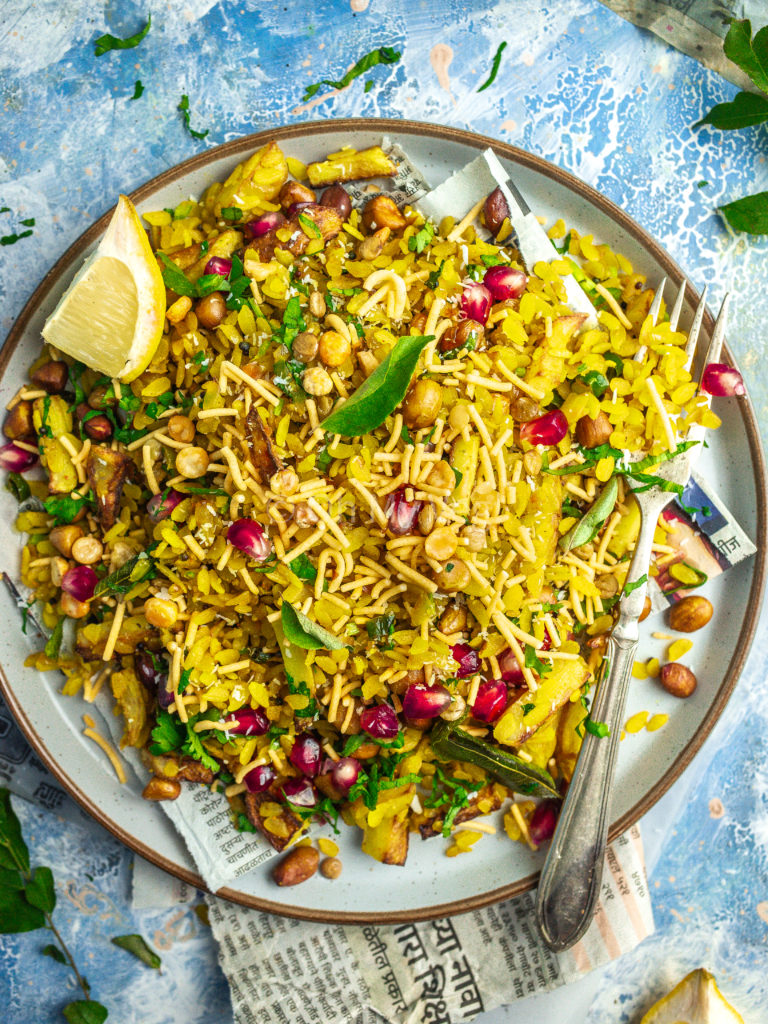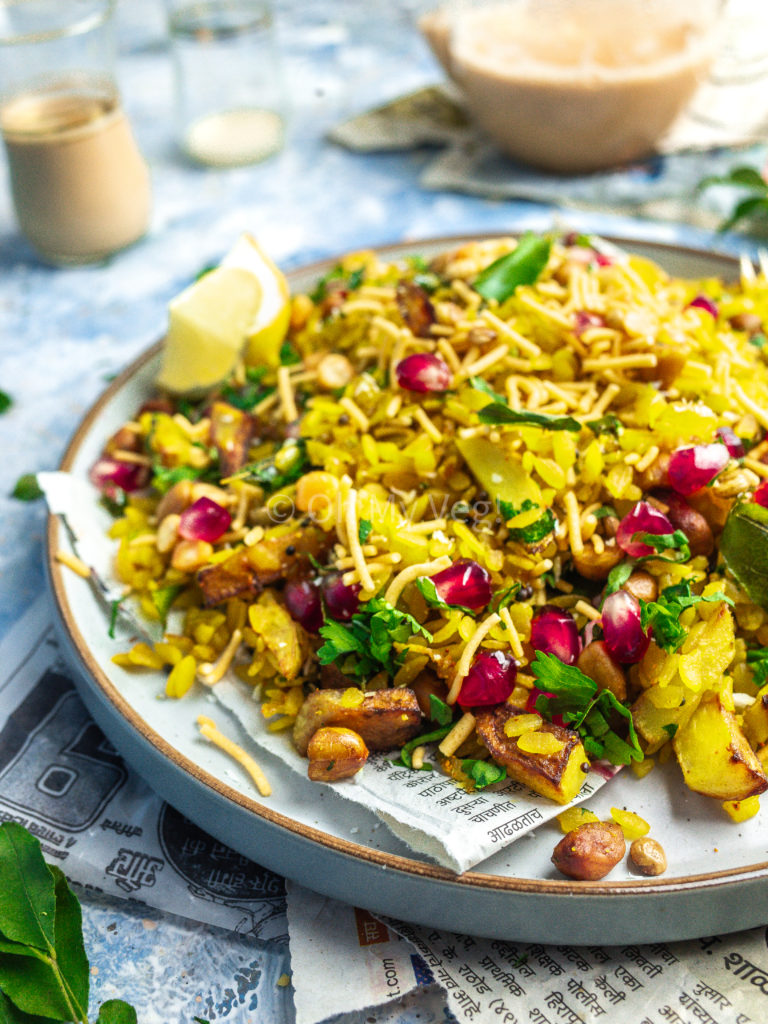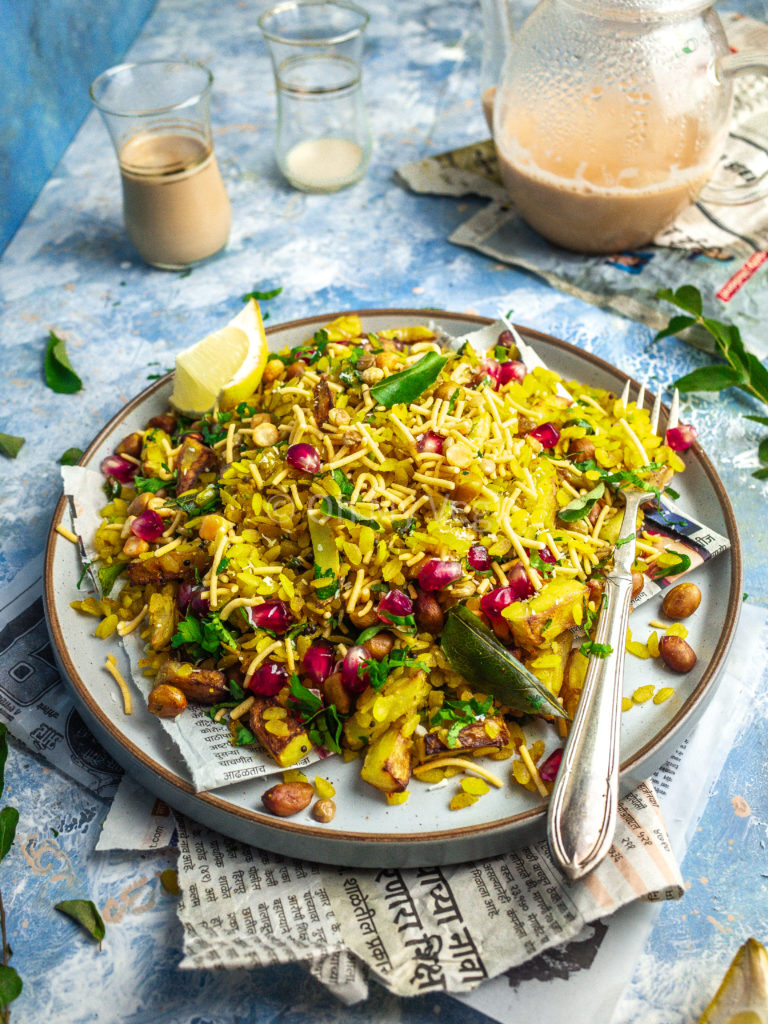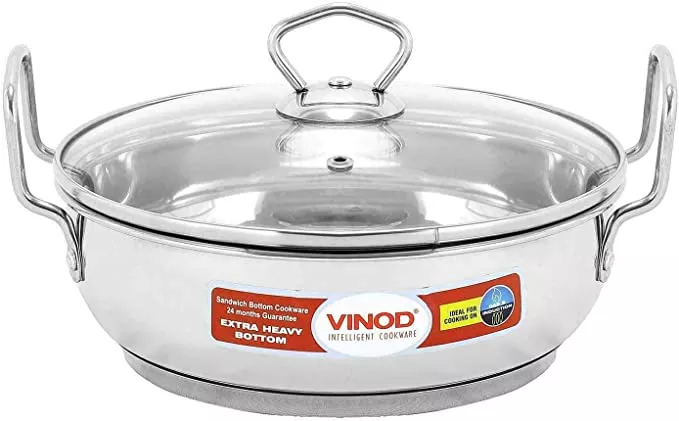Kanda Poha, Maharashtrian Batata Pohe

Breakfast is often called “the most important meal of the day,” but who’s guilty of settling for buttered toast or cereal when there are so many more exciting breakfast recipes? One of my all-time favorite breakfasts is batata poha, an Indian recipe made with turmeric-spiced flattened rice, crispy potatoes, sweet coconut, crunchy peanuts, citrusy curry leaves, and fiery chilis.
Batata poha is relished throughout India, but perhaps nowhere is it more beloved than Maharashtra, where the recipe originated. In the central Indian state, it’s so famous that it has a song named after it — and almost all households savor a big plate of steaming hot “pohe” for breakfast every Sunday. Indeed, it’s the perfect weekend treat: light and vibrantly flavored, soft and fluffy, homely and filling, and peppered with crispy nuts and garnishes. Let’s replicate that Marathi home-kitchen-style recipe …
Sunday’s are made for a breakfast of steaming hot poha.
Is Batata Poha Vegan, Gluten-Free, Dairy-Free, and Soy-Free?
Amazingly, batata poha isn’t just quick and easy — it’s vegan, gluten-free, dairy-free, and soy-free, making it suitable for almost everyone with dietary requirements. Although the base recipe isn’t nut-free, that’s easily adaptable.
To make this recipe nut-free, replace the peanuts with fresh green peas. Or, to imitate that gorgeous crunch, switch them out for spicy roasted green peas. Easy! We’ll go over more adaptations and substitutes further in the article.

What Ingredients are Used in Batata Poha?
- Poha / Flattened Rice: Three types of flattened rice are available in the market: thin poha, medium poha, and thick poha. Use medium or thick poha here. It forms the basis of our dish.
- Potato: I like fried potatoes in my poha, but you can use boiled potatoes too. Red or white potatoes are fine; opt for something starchier. They add bulk to the recipe.
- Black Mustard Seeds: Essential for Maharashtrian recipes, these black mustard seeds provide a spicy, subtly bitter pop of flavor.
- Green Chili: In this recipe, there’s no red chili powder, so all the fire comes from the green chili. It’s a warm heat, not overpowering.
- Curry Leaves: Fresh curry leaves add so much complexity. They’re aromatic, herby, citrusy, and pungent.
- Redskin Peanuts: Once fried, raw peanuts add crunch and pair beautifully with the spices.
- Onions: Sweet white or yellow onions are best, although red onions work well too.
- Turmeric: Turmeric adds a beautifully vibrant sunny color to the poha and delivers a deep earthiness.
- Sugar: Serves to balance the flavors.
- Toasted Desiccated Coconut: Adds a subtle sweetness and toasted nuttiness.
- Lemon: Squeeze lemon at the last moment before serving to get the most from the fresh citrus. It counteracts the hot spice and sweet sugar.

Tips to Make the Best Fluffy Batata Poha:
- Choose the correct variety of flattened rice. There are three standard types of flattened rice: Thin poha, medium poha, and thick poha. To make this recipe, you’ll need medium or thick poha. Either works, but avoid thin poha, as it will result in a mushy mess.
- Rinse the flattened rice. One of the biggest mistakes I see when people make poha is they soak the flattened rice for too long, which results in a soggy horror. To avoid this, rinse the poha in warm water rather than submerging it. It will soften the poha just enough.
- Stick to the recipe. It might be tempting to add extra spices, but this recipe doesn’t need them. Traditionally, poha is cooked with mustard seeds, curry leaves, turmeric, and fresh green chili — that’s it. Complicating the taste with cumin seeds, red chili powder, coriander powder, or even fresh garlic will muddy the flavors.
- Don’t burn the turmeric! Turmeric is the only powdered spice used in this recipe, and it mustn’t catch and burn on the bottom of the pan. If that happens, the dish risks becoming bitter. To avoid this, use enough oil (or water) to prevent sticking and stir immediately after adding the turmeric. Plus, we’ll add the flattened rice instantly after, too.
- Garnish, garnish, and garnish. I say it repeatedly, but garnishing your food is critical to level up your gastronomy. In the case of poha, I like to use a combination of fresh chopped coriander levels, crispy sev or similar chivda, juicy pomegranate arils, and grated coconut.
- Don’t forget the lemon. Sourness is essential to the flavor of poha. To achieve that fresh vibrancy of acidity, I like to squeeze lemon over the poha right at the end, then mix. It’s also good to serve some on the side of the plates, so everyone can add more if they want.

Variations You Can Make to Batata Poha:
- Kanda Poha: This is the most famous of all varieties of poha. It’s the same recipe as batata poha but without the potato (batata). This simple omission makes the poha even faster to cook, making it superior for rushed mornings. Its main ingredient, onions (kanda), gives the dish its name.
- Matar Poha: A widespread deviation involves adding fresh green peas to the poha. The juicy flavor of the peas pairs well with the spicy, fluffy poha. You can add peas alongside potatoes (batata poha) or onions (kanda poha) and use them fresh or frozen, depending on their availability.
- Vegetable Poha: The ultimate choice for anyone with children who don’t like to eat vegetables, this riff on poha is healthy and delicious. Add finely chopped or grated vegetables — like cauliflower, carrots, green beans, or sweetcorn — to the dish while frying peanuts. It’s one of the healthiest, most filling breakfasts that will energize you for a long time.
- Tomato Poha: Adding tomatoes brings a delicious combination of sourness and sweetness to the poha. We chop the tomatoes, add them to the pan with peanuts, cook them down until jammy, and then mix with the flattened rice. The mouthwatering flavors of sweet tomatoes will coat the poha.
- Indori Poha: Indori poha is a specialty from Indore, Madhya Pradesh. Indori poha dominates with a sweet flavor, unlike Maharashtrian poha. The distinctive taste comes from a unique spice blend, jeeravan masala, and the whole dish accompanies a sugary Indian sweet, jalebi.
- Tari Pohe: A personal favorite, people can find this street food in Nagpur, northeast Maharashtra. Either kanda poha or batata poha forms the base of the dish, but that’s not all — street vendors top the fluffy rice with an aromatic and fiery sauce filled with black chickpeas called “tari.” The moreish spicy flavor comes from unusual Saoji spicing and a Maharashtrian spice blend called kala masala.

This Recipe Is …
- Vegan, Gluten Free, Dairy Free, Soy Free
- Adaptable to be Nut Free!
- Healthy and tasty
- Authentically Maharashtrian
- Quick — ready in 15 minutes or less
- Perfect for breakfast, lunch, or evening snacks

Kanda Batata Poha - Quick Maharashtrian Breakfast
Maharashtrian batata poha is the perfect breakfast recipe: Quick, easy, vegan, and beautifully flavored with simple spicing.
Ingredients
- 120g Medium Poha
- 2 tbsp Neutral Oil of your choice
- 1 Medium Potato (80g), peeled & cut into small pieces
- 3/4 tsp Black Mustard Seeds
- 3 Thin Indian Green Chili, finely chopped
- 6 Fresh Curry Leaves*
- 20g Raw Redskin Peanuts
- 60g White Onion, finely chopped
- 1/2 tsp Turmeric Powder
- Sea Salt, to taste
- 1/4 tsp Sugar, optional
- 1 tsp Desiccated Coconut, toasted (optional)
- 4 Strands Coriander (Stalks & Leaves), finely chopped
- Sev, to garnish
- Lemon Quarters, to garnish
- Pomegranate Arils, to garnish (optional)
Instructions
- To begin, fry the potato**. In a large frying pan or kadai, heat 2 tbsp of neutral oil over medium heat. Once the oil is hot add the chopped potato and fry until golden brown. Once cooked, remove from the oil, drain on paper towels, and set aside until needed.
- Rinse the rice flakes. While the potato is cooking, prepare the rice flakes. Put the rice flakes into a sieve and gently run warm water over it. Move the poha around with your hand, rinsing until the rice flakes feel soft. Once done, set the sieve over a pot to drain excess water, and fluff the rice flakes to make them fluffy.
- To cook the poha, use the remaining oil in the frying pan or kadai to pop black mustard seeds. Next, add the green chilis, fresh curry leaves, and raw peanuts. Cook everything for around 30 seconds, then add the onions. Stirring frequently, cook until the peanuts are crunchy and the onions are translucent. At this stage, add turmeric powder and stir immediately, being catch to not let the spice burn.
- Immediately add the rinsed rice flakes to the pan along with salt, sugar, desiccated coconut (if using), and cooked potatoes. Mix everything well, until coated. Cook for a further minute, then stir through the freshly chopped coriander.
Serve garnished with more fresh coriander, crispy chivda or sev, and pomegranate arils.
Notes
* If you don't have access to fresh curry leaves, simply omit them from the recipe.
** As opposed to frying the potato, you can also steam or boil it. Cook's choice!
Recommended Products
As an Amazon Associate and member of other affiliate programs, I earn from qualifying purchases.
Nutrition Information:
Yield: 2 Serving Size: 1Amount Per Serving: Calories: 605Total Fat: 29gSaturated Fat: 3gTrans Fat: 0gUnsaturated Fat: 23gCholesterol: 0mgSodium: 462mgCarbohydrates: 81gFiber: 12gSugar: 28gProtein: 13g
Nutrition information isn’t always accurate.










First of all: stunning photography!! Secondly, if a dish has a song written about it then it must be legendary. Can’t wait to try!!
Thank you so much, Heather! It certainly lives up to the legend 😍 Please do let me know what you think when you cook it.
WOW, what an interesting breakfast dish. I love how all the ingredients are healthy, can we make this without the sugar?
Thanks, Lisa! You can enjoy the batata poha without adding sugar since the toasted coconut provides enough sweetness. Alternatively, you can skip both ingredients, and it will still be just as delicious!
I couldn’t agree more! While there’s nothing wrong with buttered toast or cereal, trying new breakfast recipes is always exciting. Batata poha sounds delicious! I love the combination of flavours and textures, and the fact that it’s a popular breakfast dish in Maharashtra adds to its appeal. Thanks for sharing this recipe idea – I can’t wait to try it!
Thank you so much Sonia! I can’t wait for you to try it either. I love buttered toast on busy weekdays but I like to go all-out with my breakfast (or brunch) on weekends!
Hmm, I’ve been looking for something like this to eat. Thanks. I’ll try it out.
Do let me know what you think of the poha when you make it Richard!
I have lived my half life in Mumbai, and I must say your recipe for Kanda Batata Poha brings back delightful memories of my mornings there. The detailed instructions and the healthy twist to this Maharashtrian breakfast are impressive. Can’t wait to try it out!
This was such a lovely comment to receive, thank you! I’m so glad seeing this dish could bring memories of those happy times back to you. Hopefully it lives up to the pohe from Mumbai!
What an amazing combination of flavors and with rice and potatoes will keep you satisfied for a long time!
I love the colors on that dish. What a lovely breakfast to make!
Thanks for the lovely comment! I agree, it’s so important to eat all the colors of the rainbow and have beautiful vibrant food.
I couldn’t agree more with this post! Breakfast is definitely an opportunity to explore more exciting recipes, and batata poha sounds absolutely delicious. The combination of turmeric-spiced flattened rice, crispy potatoes, sweet coconut, crunchy peanuts, and aromatic curry leaves creates a tantalizing flavor profile that I can’t wait to try.
Thanks so much, Rhea! Mahahrastrian batata poha definitely has an incredible range of textures and flavors from all the diverse ingredients, you’ve got that spot on.
It looks absolutely divine, but am I reading it right? green chillies? As in, you may take a bit of a spoonful of the dish with a slice of chilli in it? Wow! I love it already and I haven’t even tried it yet.
Thanks May! That’s right, batata poha has fresh green chilis mixed through. They give a nice warm heat without being too fiery, but you can adjust the quantity to your spice preference! Please let me know how you get on with the recipe once you try it.